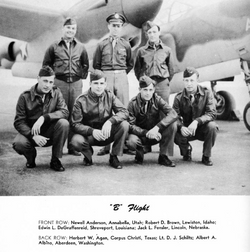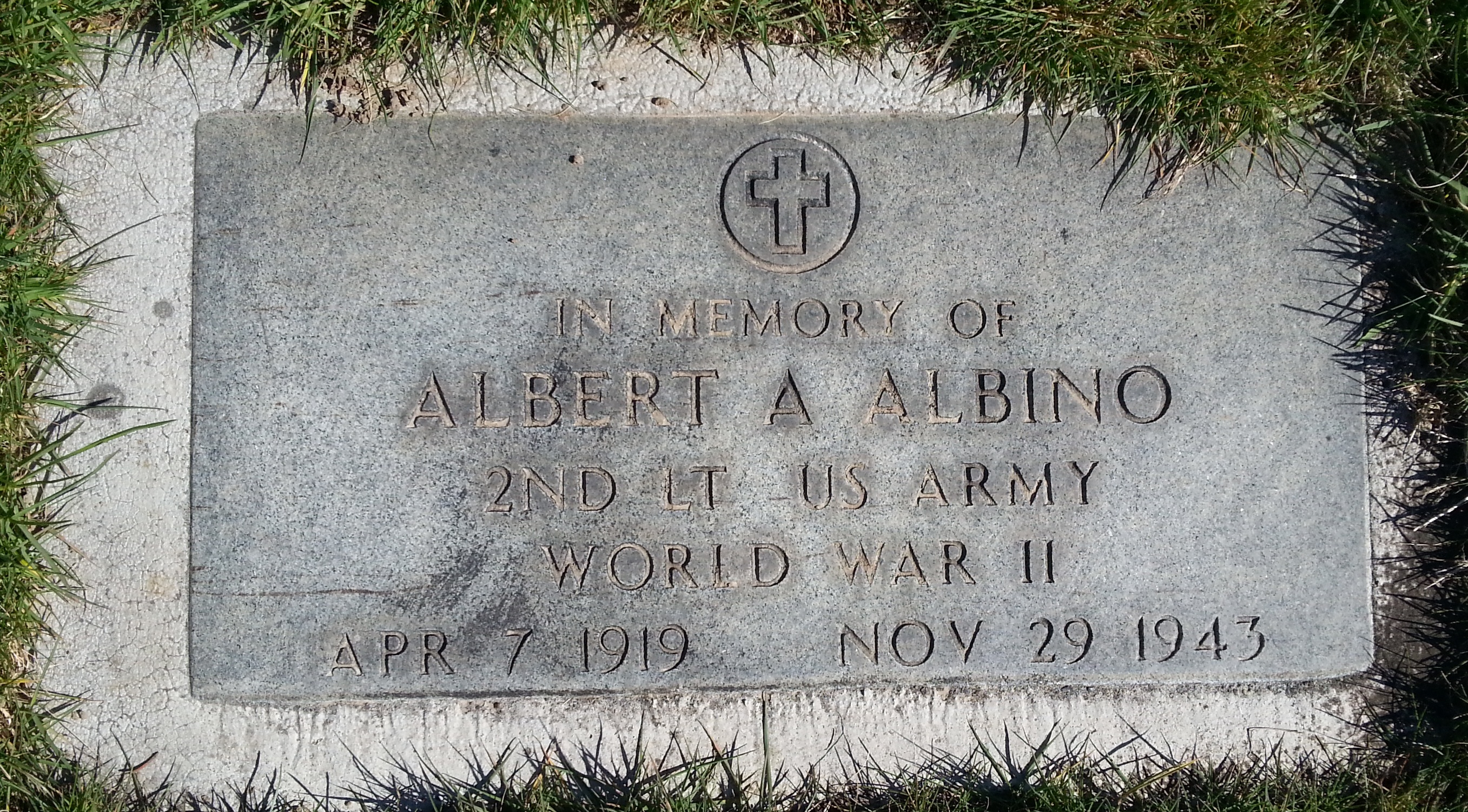He was KIA on mission when he was shot down by a several Enemy Planes (ME-109) and crashed near Hoogeveen, Holland on Nov. 29, 1943. (provided by Jean Louis Vijgen)
Aviation journalist Gerrit Boxem from Hoogeveen found a special story in the archives.
That of Albert Albino (24) who, after an air fight with his Lightning P38, crashed behind Hoogeveen station and remained missing for 35 years.
WRITTEN BY
Lydia Tuijnman
Dozens of Messerschmitts
"It is overcast over Western Europe on November 29, 1943," says Boxem. "At Bergen aan Zee, via Lemmer, Noordwolde and Grolloo, the bombers and their escorts fly to Bremen. There is little German opposition and the mission seems to be a 'piece of cake'. But nothing could be further from the truth. The way back for the American pilots is in fact an outright hell walk. Just before they have reached the point where they want to regroup for the return flight, the Americans are suddenly attacked by dozens of Messerschmitt Me-109 hunters. "
Several Lightnings are immediately fatally hit and crash. The other American hunters form groups of four aircraft, making them stronger against the attacks. One of the devices that cannot be connected to such a quartet is that of Albert Albino. He does not return to the base.
Missed in action
Boxem: "His fate has remained unknown for a long time. Even after the war, the American army made every effort to find its missing soldiers. Archives are searched and eyewitnesses questioned, but no matter how they are searched. : no trace of Albert Albino. No connection is made with a crashed plane in Hoogeveen, that is far too far from the line in which the Lightnings flew. "
Deep crater
On that same fateful afternoon, eyewitnesses in Hoogeveen had seen a hunter with enormous speed dive into the ground next to the station building. A parachute hung from the baggage hall. He suggested that the pilot had made an attempt at the last minute to jump out of his plane. It must have been a huge blow, Boxem suspects. "The rails stood upright and a deep crater was visible between them.
Because the Germans needed the rail link for the Jews' transports, the pit was closed without much ceremony and the rails were repaired."
High cost
Gerrit Boxem believes that Albino could have been found twice before. "After the war, the Gravingdienst made a half-hearted attempt at the station to salvage the remains of the unknown pilot, but because of the high costs that was not the case. If a first tunnel was dug under the railway in September 1972, one encounters a few metal parts of an aircraft. Because it is assumed that the other remains have sunk too deep into the peat soil, further disposal is not required. "
Name plate
Eventually in 1978 the riddle is solved when the Dutch Railways start working on the construction of a pedestrian tunnel under the railway at the station of Hoogeveen. Again wreckage from an aircraft is encountered. Now adequate action is being taken, Boxem says.
"The train traffic is stopped and the Air Force Salvage Service and the Engraving Service are notified. It soon becomes clear that one has to deal with the wreckage of an American P-38 fighter. material remains and some items of equipment from the pilot. A military nameplate brings certainty. It is the Albert Albino missing since 1943. That he had managed to get to Hoogeveen no one had thought during the post-war search. "
The remains of Albino are transferred to the United States at the request of his brother, where they were buried in a local church cemetery in Portland, Oregon, in October 1978. "He is finally home," Boxem sighs. On the Hoogeveense Stationsplein there is a monument consisting of a propeller blade of the P38 of the young air hero Albino, which was decorated with a Purple Heart, among other things.
Contributor: usafdo (48612389)
He was KIA on mission when he was shot down by a several Enemy Planes (ME-109) and crashed near Hoogeveen, Holland on Nov. 29, 1943. (provided by Jean Louis Vijgen)
Aviation journalist Gerrit Boxem from Hoogeveen found a special story in the archives.
That of Albert Albino (24) who, after an air fight with his Lightning P38, crashed behind Hoogeveen station and remained missing for 35 years.
WRITTEN BY
Lydia Tuijnman
Dozens of Messerschmitts
"It is overcast over Western Europe on November 29, 1943," says Boxem. "At Bergen aan Zee, via Lemmer, Noordwolde and Grolloo, the bombers and their escorts fly to Bremen. There is little German opposition and the mission seems to be a 'piece of cake'. But nothing could be further from the truth. The way back for the American pilots is in fact an outright hell walk. Just before they have reached the point where they want to regroup for the return flight, the Americans are suddenly attacked by dozens of Messerschmitt Me-109 hunters. "
Several Lightnings are immediately fatally hit and crash. The other American hunters form groups of four aircraft, making them stronger against the attacks. One of the devices that cannot be connected to such a quartet is that of Albert Albino. He does not return to the base.
Missed in action
Boxem: "His fate has remained unknown for a long time. Even after the war, the American army made every effort to find its missing soldiers. Archives are searched and eyewitnesses questioned, but no matter how they are searched. : no trace of Albert Albino. No connection is made with a crashed plane in Hoogeveen, that is far too far from the line in which the Lightnings flew. "
Deep crater
On that same fateful afternoon, eyewitnesses in Hoogeveen had seen a hunter with enormous speed dive into the ground next to the station building. A parachute hung from the baggage hall. He suggested that the pilot had made an attempt at the last minute to jump out of his plane. It must have been a huge blow, Boxem suspects. "The rails stood upright and a deep crater was visible between them.
Because the Germans needed the rail link for the Jews' transports, the pit was closed without much ceremony and the rails were repaired."
High cost
Gerrit Boxem believes that Albino could have been found twice before. "After the war, the Gravingdienst made a half-hearted attempt at the station to salvage the remains of the unknown pilot, but because of the high costs that was not the case. If a first tunnel was dug under the railway in September 1972, one encounters a few metal parts of an aircraft. Because it is assumed that the other remains have sunk too deep into the peat soil, further disposal is not required. "
Name plate
Eventually in 1978 the riddle is solved when the Dutch Railways start working on the construction of a pedestrian tunnel under the railway at the station of Hoogeveen. Again wreckage from an aircraft is encountered. Now adequate action is being taken, Boxem says.
"The train traffic is stopped and the Air Force Salvage Service and the Engraving Service are notified. It soon becomes clear that one has to deal with the wreckage of an American P-38 fighter. material remains and some items of equipment from the pilot. A military nameplate brings certainty. It is the Albert Albino missing since 1943. That he had managed to get to Hoogeveen no one had thought during the post-war search. "
The remains of Albino are transferred to the United States at the request of his brother, where they were buried in a local church cemetery in Portland, Oregon, in October 1978. "He is finally home," Boxem sighs. On the Hoogeveense Stationsplein there is a monument consisting of a propeller blade of the P38 of the young air hero Albino, which was decorated with a Purple Heart, among other things.
Contributor: usafdo (48612389)
Family Members
Sponsored by Ancestry
Advertisement
Advertisement














